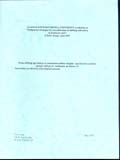| Report |
 |
|
| Title | From shifting agriculture to sustainable rubber complex agroforestry systems (jungle rubber) in Indonesia: an history of innovations production and adoption process | | Author | Eric Penot | | Year | 1997 | | Institution | International Centre for Research in Agroforestry, SEA Regional Research Programme and Cornell University Press | | City | Bogor, indonesia | | Number of Pages | 27 | | Call Number | RP0010-04 | | Keywords | Shifting Agriculture, Complex agroforestry systems, Jungle rubber, Rubber cropping Patterns, Innovations adoption process |
|
| Abstract: |
| The plains of Sumatra and Kalimantan below the altitude of 500 meters (our study area) were scarcely inhabited at the turn of the 19th century with a population densitty less than 4 inhabitants/km2, mainly relying on shifting cultivation of upland rice. The introduction of rubber by private dutch astates in the decade 1910-1920 triggered a radical change in the landscapes evolution, but not in farmers practices, at least at the beginning. As estates adopted monoculture right from the beginning, trying to maximize rubber production, farmers saw and exploited immediately the possibility of growing rubber on a very extensive way by enriching their fallows (belukar in Indonesia) with unselected rubber seedlings that were available and free. Planting rubber during, or after, upland rice was a very marginal supplementary amount work, with no risks and more important : no cost. Rubber was ground with the secondary forest in a complex agroforestry system called "jungle rubber".
Productivity was suffucient to raise a very reasonable income however rubber tapping commences later than in monoculture in estates.
The advatages of jungle rubber are clear : no costs (planting material, fertilizers), no labour required for maintenance during inmature period, income diversification with fruits, rattan, timber and other NTFP (non timber forest products) from the agroforest. Indirect benefits are environmental with soil conservation ang rehabilitation of degraded lands. Originally, the adoption of this system did not change farmers' older pratices and, beside rubber production, they continued to slash and burn new plots every year. At that stage one can still consider jungle rubber as an "enricheed fallow with rubber".
Estates began to conduct their own research programme in the 1920's leading to the adoption of several important innovations : fertilization, weeding level, exploitation systems. Among them improved planting material, the clones, has been the most important in terms of yield. Meanwhile farmers began to introduce several innovations, with no cost, called "endegenous innovations" such as planting in lines, a minimum weeding (once a year).mainly through the improvement of some rubber farming practices. That step is called "endogenous innovation production" (by farmers). These innovations are not coming from estates (except the original rubber stock).
At that stage as the aim was definitely to establish a rubber system minimizing capital and labour investment, farmers shifted from an "enriched fallow with rubber" to a real "complex rubber agroforestry system".
The productivity of jungle rubber being low (500 kg/ha/year/ of rubber) compared to that of estates using clones (1500 to 2000 kg/ha/year), and after having completed the possibilities of endogenous innonation production, farmers began to be interested to include "external innovations" such as clones, fertilization ang goo tapping systems.
Some who had access to clonal rubber in monoculture began also to develop innovations such as intercropping during immature period and planting of perennial trees (or selection of those from natural regeneration) such as fruit and timber trees creating therefore an "improved rubber bas
ed complex agroforestry system" where the original aim of improving the fallows has disappeared before the willingness to establish a real cropping system. These practices were still forbidden in rubber development projects only 5 years ago. Population increase, land scarcity in some areas and other more productive ans sometimes intensive rubber Agroforestry System (RAS).
Research in agroforestry has been very recently focused on how to integrate indigenous knowledge with jungle rubber and external innovations to raise productivity, while conserving benefits of agroforestry practices in terms of enviroment and biodiversity. |
|